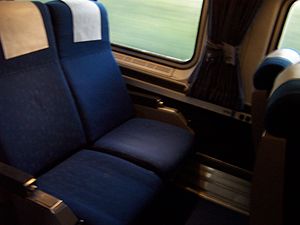Amfleet
| Amfleet | |
|---|---|

Amfleet I coaches at Kingston, Rhode Island
|
|

Amfleet coach seats
|
|
| In service | 1975–present (Amfleet I) 1981–present (Amfleet II) |
| Manufacturer | Budd Company |
| Built at | Philadelphia, PA |
| Family name | Budd Metroliner |
| Number built |
|
| Formation | Single car |
| Fleet numbers |
|
| Capacity | Up to 84 seats |
| Operator(s) | Amtrak |
| Specifications | |
| Car body construction | Stainless steel |
| Car length | 85 ft 4 in (26.01 m) |
| Width | 10 ft 6 in (3.20 m) |
| Height | 12 ft 8 in (3.86 m) |
| Floor height | 51 1⁄2 inches (1.31 m) |
| Platform height | 17 inches (430 mm) |
| Doors |
|
| Maximum speed | 125 miles per hour (201 km/h) |
| Weight | 106,000–113,000 pounds (48,000–51,000 kg) |
| Power supply | 480 V AC |
| Train heating | Electric heat and air conditioning |
| Bogies | Budd Pioneer |
| Braking system(s) | Pneumatic, 2 tread and 2 disc per axle. |
| Coupling system | AAR type H |
| Track gauge | 4 ft 8 1⁄2 in (1,435 mm) standard gauge |
Amfleet is a fleet of single-level intercity railroad passenger cars built by the Budd Company for American company Amtrak in the late 1970s and early 1980s. Budd based the Amfleet design on its earlier Metroliner electric multiple unit. An initial order for 57 cars in 1973 to supplement the Metroliners on the Northeast Corridor grew to two orders totaling 642 cars, sufficient to reequip all the services on the Northeast Corridor and many other routes around the United States.
The Amfleets were the first new locomotive-hauled intercity cars ordered by Amtrak and the first such cars built in the United States since 1965. The introduction in the mid-1970s led to improved reliability for Amtrak's trains and ridership gains. As of 2015, Amfleet cars are used extensively in the eastern and mid-western United States, forming the backbone of Amtrak's single-level fleet.
Amtrak assumed control of almost all private sector intercity passenger rail service in the United States on May 1, 1971, with a mandate to reverse decades of decline. Amtrak retained approximately 184 of the 440 trains which had run the day before. To operate these trains, Amtrak inherited a fleet of 300 locomotives (electric and diesel) and 1190 passenger cars, most of which dated from the 1940s–1950s. These cars were aging, in need of maintenance, and in many cases incompatible with each other. Amtrak recognized the need and opportunity to standardize on a single design.
Very few railcars had been built for inter-city service in the United States since the 1950s; the last locomotive-hauled cars were an order of ten coaches built by Pullman-Standard for the Kansas City Southern Railway in 1965. An important exception was the Budd Metroliner electric multiple unit. This fleet of 61 cars had begun operation on the Northeast Corridor in 1969 under Penn Central and quickly gained acceptance with the traveling public, despite various engineering problems. Writing in the mid-1970s, railroad historian John H. White Jr. described them as "Amtrak's brightest star." In 1973 Budd still had the tooling in place from the Metroliner order, meaning that any new order derived from that design could begin almost at once.
...
Wikipedia
